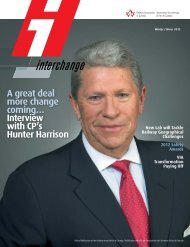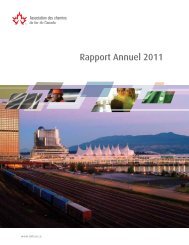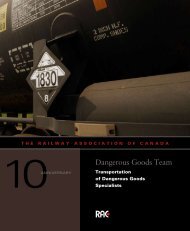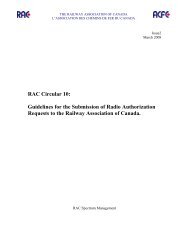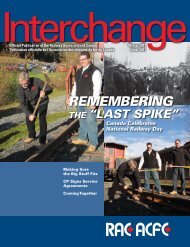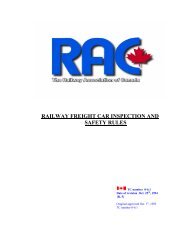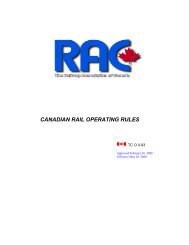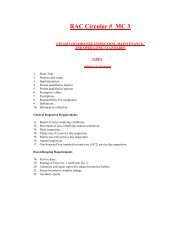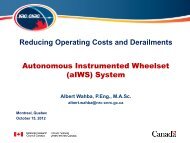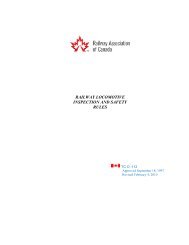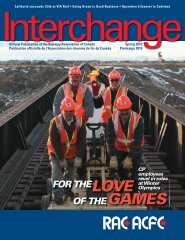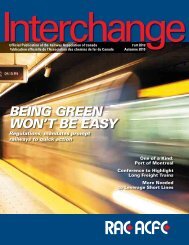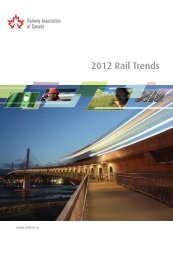Locomotive Emissions Monitoring Program - Railway Association of ...
Locomotive Emissions Monitoring Program - Railway Association of ...
Locomotive Emissions Monitoring Program - Railway Association of ...
Create successful ePaper yourself
Turn your PDF publications into a flip-book with our unique Google optimized e-Paper software.
Annex 5<br />
Reduction Of Greenhouse Gas <strong>Emissions</strong> From The Rail Sector<br />
The Action Plan for Reducing GHG <strong>Emissions</strong> may include the following kinds <strong>of</strong> elements:<br />
Operational Improvement<br />
• Consolidation <strong>of</strong> cars with similar destination into blocks: This step reduces delays at intermediate locations<br />
by simplifying process for employees, eliminating the duplication <strong>of</strong> work and helping to ensure fluid rail yards<br />
and terminals. It also reduces transit time for shipments throughout the network and increases car availability<br />
for customers.<br />
• Scheduling: There are methods to improve the scheduling <strong>of</strong> trains with other railways and develop systems<br />
designed to share advanced information to thereby improve service.<br />
• Distributive power: It enables the placement <strong>of</strong> locomotives at different locations throughout a train, as opposed<br />
to placing all the locomotives at the front <strong>of</strong> the train. This allows for improved acceleration, braking and overall<br />
control <strong>of</strong> the train especially where severe grades and curvature exist. Better rail-wheel adhesion and improved<br />
application <strong>of</strong> available motive power increases fuel efficiency, and improved train handling capabilities improves<br />
throughput and reduces costs.<br />
• Code for best practices: The development and promotion <strong>of</strong> a code will allow the sharing <strong>of</strong> best practices<br />
amongst all railways and increase the use <strong>of</strong> such best practices thereby generating additional fuel savings for<br />
the industry.<br />
Technology / Equipment Upgrades<br />
• Anti-idling devices and strategies: Studies show that idling locomotives consume approximately four per cent<br />
<strong>of</strong> the total volume <strong>of</strong> fuel consumed in railway operations. Technologies such as automatic stop/start systems<br />
and hybrid switching locomotives as well as operational changes can potentially reduce idling significantly and<br />
generate important fuel savings.<br />
• Equipment: Equipment upgrades include using improved steel wheel tread pr<strong>of</strong>iles, lightweight rail cars, and the<br />
introduction <strong>of</strong> “steering trucks” on rail cars. These new materials and designs reduce the weight <strong>of</strong> freight cars<br />
and their rolling resistance, enabling to haul more cargo per unit <strong>of</strong> energy used.<br />
Greater participation in federal programs<br />
Examples <strong>of</strong> federal programs include:<br />
• Freight Technology Demonstration Fund: Under this program, Transport Canada is funding projects that can<br />
demonstrate and encourage the take-up <strong>of</strong> technologies and best practices that can reduce both CAC and GHG<br />
emissions from any freight mode.<br />
• Freight Technology Incentives <strong>Program</strong>: The program provides financial incentives for the purchase and<br />
installation <strong>of</strong> efficiency enhancing and emissions reduction technologies and equipment in any freight mode.<br />
48 LEM 2008




